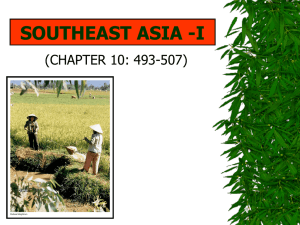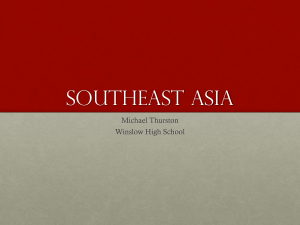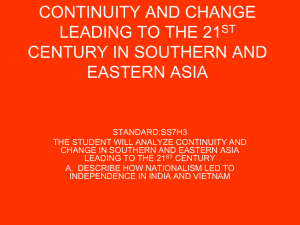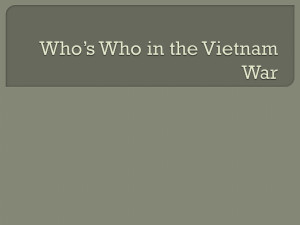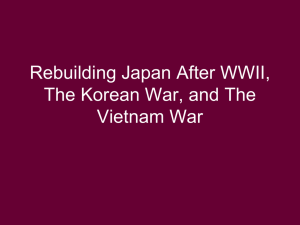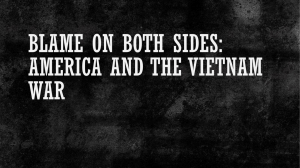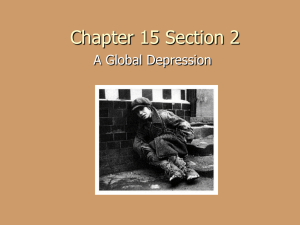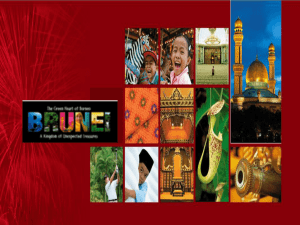Southeast ASIA (CONTINUED) PLUS JAPAN AFTER 1945
advertisement
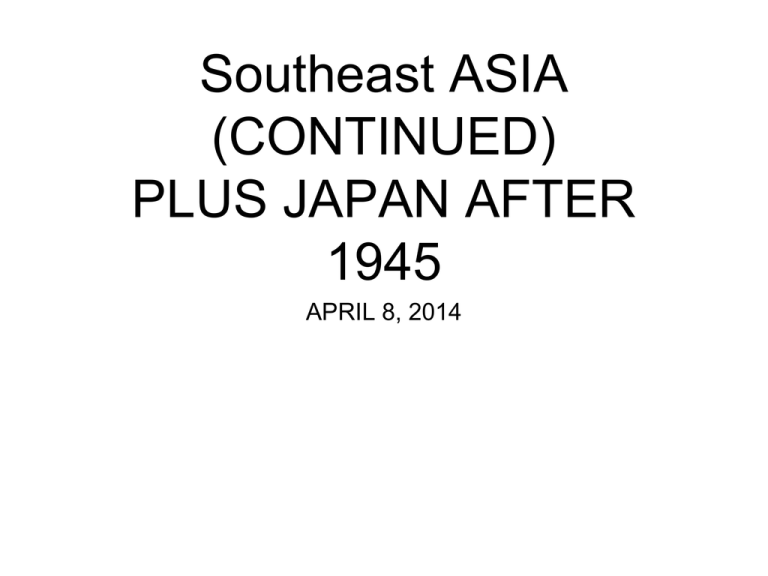
Southeast ASIA (CONTINUED) PLUS JAPAN AFTER 1945 APRIL 8, 2014 Review What sorts of ethno-religious conflicts can we see in modern Southeast Asia? Which is the richest country in Southeast Asia? Is it a democracy? What is the poorest country in Southeast Asia? Is it a democracy? Which is the most democratic country in Southeast Asia today? (Where have we seen at least two peaceful transfers of power?) Malaysia (pp. 167-69, 18689) Communist (primarily Chinese) rebellion slowed progress toward independence Major issue has been the attempts by Malays to ensure their numerical superiority is reflected in political and economic superiority. Ruling party is a coalition of Malay, Chinese, and Indian parties. Malays dominate. The ruling party has never lost a national election but their share of the vote has been dropping recently. However, Malaysia has yet to experience a peaceful transfer of power. The ruling party won a close election in 2013. Singapore (pp. 190-91) Communal tensions with Malays led to Singapore separating from Malaysia in 1965. Under leadership of Lee Kuan Yew, Singapore became a trading and financial centre, making it very wealthy There are elections, but the ruling party always wins, and the opposition never wins more than a few seats. Opposition politicians are sometimes charged in civil suits with “insulting” the leaders of the government. There is no real freedom of speech or freedom of the press in Singapore. Don’t confuse a free market with democracy. The first is economic. The second is political. religion, ethnicity, and national identity Indonesia: everyone is required to believe in one God. Most are Muslims (Buddhists and Hindus are treated as believing in one God.) Malaysia: Ethnic Malays are supposed to be Muslims Thailand: to be a real Thai, you should be Buddhist. Burmese also define themselves as Buddhists. That causes problems for religious minorities. Chinese maintain a separate cultural identity in some Southeast Asian countries by frequenting Chinese temples. Indochina after 1945 http://cdn.angiesdiary.com/wpcontent/uploads/2012/06/indochina_map.jpg Vietnam (pp. 153-59, 19193) Vietnam, which had been divided into three separate colonies under the French, resisted the return of the French in 1945. War with the French ended in 1954 with the division of Vietnam into a Communist north and an anti-Communist (but not democratic) south. With Ho Chi Minh, a Communist nationalist, as the leader in the North, a guerrilla war to unite north and south begins in the late 1950s. The US intervenes to defend the government of the south. The Americans admit defeat in 1973. Vietnam is united under a Communist government in 1975. Vietnam began imitating China’s economic reforms in 1986. It now, like China, combines a mixed economy (some capitalism, some state control) with authoritarian rule. Ho Chi Minh Ho Chi Minh in Wikipedia http://en.wikipedia.org/wiki/Ho_Chi_Minh Not an acceptable source to use in your term paper. But the pictures are interesting. Instead, you can use the New York Times obituary: http://www.nytimes.com/learning/general/onthisday/bday/0519.html Cambodia’s tragedy (160-62, 194-96) Freed from French control in the 1950s, Cambodia tried to remain neutral in the battle between north and south Vietnam. The US supported General Lon Nol’s overthrow of the neutral government of Sihanouk in 1970. That, plus US military attacks on Cambodia, allowed the Khmer Rouge to seize the nationalist banner. They took over Cambodia in 1975 and embarked on a “purification” of the population that cost over 1.5 million dead. Vietnam invaded in 1979 and forced the Khmer Rouge from power. Cambodia’s prime minister is a former Khmer Rouge who first gained power with Vietnamese help and has stayed in power ever since, even though there have been elections. The killing fields http://news.bbc.co.uk/2/hi/programmes/from_our_own_correspondent/9251334.stm Don’t forget Laos (pp.160, 193-94) A small country caught up in the battle for Indochina. The war in Vietnam spilled over into Laotian territory. When Vietnam and Cambodia went Communist, so did Laos (the Communist forces were led by a Communist prince!) Laos is now ruled by the Lao People’s Revolutionary Party, with no other political parties permitted. There is a mixed economy and an authoritarian political system. Brunei (p. 191) An often overlooked country that is relatively rich (because of oil). Less than 425,000 people live in Brunei. Still an absolute monarchy (sultanate) 11-20% of the population of Brunei are of Chinese background. Brunei on the map http://4.bp.blogspot.com/-xoJVLYdd0kQ/UM6wXMDNKI/AAAAAAAADvg/leCTAvE56LU/s1600/this_is_brunei.jpg Major Violence in SE Asia 1945-75 War in Vietnam (pp. 153-59) 1965 Massacre in Indonesia (p. 173) 1975-78 Killing fields in Cambodia (p. 194) plus on-going violence in Thailand, the Philippines, Timor-Leste, and Burma/Myanmar Douglas MacArthur, Asia’s greatest revolutionary 1945-1952 Japan is occupied by a foreign power for the first time in its history Demilitarization of Japan, including putting war criminals on trial (but why was the Emperor left on his throne? pp. 462-3), then Article 9 of the new constitution. (p. 463) social revolution--land reform for peasants, workers can now form labour unions, women are now legally equal to men, the individual is the basic unit of society rather than the family. Japan gets democracy Militarists lose power, and landlords lose their land under American land reform. At the same time, businessmen get out from under the thumb of the government, and from the zaibatsu (conglomerates of interlocked companies) The MacArthur constitution gives Japan parliamentary government, equality for women, freedom of speech and press, freedom for workers to organize. The MacArthur constitution outlaws war for Japan. Was Douglas MacArthur Asia’s greatest revolutionary? Japan The Liberal Democratic Party was replaced as the ruling party by the Democratic Party of Japan in 2009. Then, in 2012, the voters returned the LDP to power. That’s two peaceful transfers of power The peaceful transfer of power to the DPJ brought an end to over 50 years of Liberal Democratic Party hegemony. Japan is still bound by article 9 of the MacArthur Constitution, but is becoming more outspoken in its foreign policy. Japan still has problems with minorities like burakumin, Ainu, Koreans and Okinawans. (p. 516) Japan is unusual in that a religious party plays a minor but significant political role. Soka Gakki remains a political and religious force. (The New Kōmeitō political party is associated with SGI.) (p. 468) What is democracy? • a political system grounded in the recognition of the legitimacy of conflicts of interests. Democracy provides mechanisms such as elections for the peaceful resolution of such conflicts. There also must be a real possibility for citizens to influence policy and even to form opposition parties that can themselves someday run the government Many scholars withhold the label “democracy” from a country that has not experienced two peaceful transfers of power in a row. the Japanese economy Japan recovered quickly after the war, and began growing rapidly (until the 1990s) Administrative guidance from the government directed investment into more productive channels. Japan has had a stable government--perhaps too stable. From 1955 to 2009, most of the time the Liberal Democratic Party governed Japan (except for 1993-1996). The Democratic Party of Japan held the majority of the seats in the Diet and ran the government from 2009 until Dec. 2012, when the LDP again won the election and control of the government. Japan’s Economic Rise In the 1950s and 60s, Japan had the fastest growing economy in the world. How did Japan do that? It rebuilt from the destruction of war with brand new technology, and with the aid of Korean War contracts. The government offered advice to ensure capital was concentrated in the most appropriate sectors The US took care of Japan’s defence needs, allowing Japanese capital to be put to peaceful use. Japan: No Longer #1 Starting in 1990--2 decades of economic stagnation. Japan now has a lower per capita GDP than Singapore, Hong Kong, Taiwan --and Canada. But it is not a poor country. It is still 36th in the world, and has the world’s 5th largest national economy (behind the US, the EU, China, and India). Japan has the largest government deficit in the world, as a percentage of annual GDP. More than Greece, Italy, Iceland, or the US. An aging and shrinking population, plus a reliance on exports, makes hopes for a return to the boom days of the 1960s and 1970s look unlikely. Even the shift in 2009 to DPJ from LDP and back again to the DLP in 2012 has made little difference. Japan and Its Neighbours China: The legacy of the Pacific War Disputes over the Senkaku/ Diaoyutai islands Korea: North and South Rocky relations with North Korea because of kidnapped Japanese, disputes with South Korea over both Dokto /Takeshima Island and over history Russia: Who owns the Kurile islands? Questioning Japan New religious movements: Aum Shinrikyo (now Aleph) and Happy Science (says its still living founder is the Buddha incarnate) (p. 522) Nihonjinron--search for the the uniqueness of the “Japanese race.” Unique language, homogeneous people, and unique psychology and even physiology. (p. 516) Making Japan a “normal country” (able to wage war). Okinawa after 1945 Conquered by the US in a bloody battle in spring, 1945 Occupied by the US until 1972 (occupation of the rest of Japan ended in 1952) Taiwan protested the reversion to Japan. (Some in the PRC now claim that the Kingdom of the Ryūkyūs was part of China!) Still has more US military personnel than all of the rest of Japan Average income is 75% of the average income of Japanese on the main islands.
